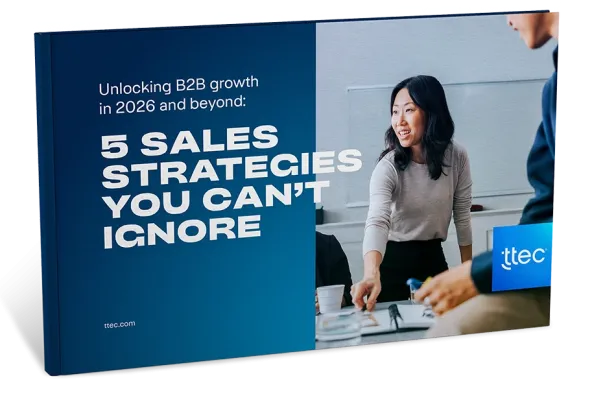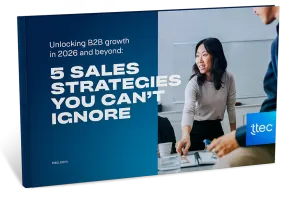Terabyte. Petabyte. Exabyte. Zettabyte. Yottabyte. These words represent the enormity of data that businesses can use to drive improved economic value. And if you're in a senior executive position, it's definitely part of your job to figure out what to do with it.
The ability to collect, store, and utilize data in a way that can lead to unique competitive advantage has become a top strategic priority for almost every CEO. And though companies have vastly improved those capabilities, customer experience improvements still lag woefully behind. In fact, most customer experiences have hardly budged at all, even as new data possibilities emerge that give companies the power to deliver a proactive, frictionless customer experience.
Why hasn't customer experience kept up with Big Data advances? Because most companies don't start with the end customer in mind. Instead, they let smaller business objectives and a technology focus drive the experience. And that's exactly the wrong approach for long-term success.
Some would argue that we are on the third or fourth generation of Big Data strategy. The first generation was about building the warehouses to collect the "structure" data, and then executing basic campaigns all in batch mode after the fact. The second generation was about creating more sophisticated customer offers for increasingly smaller customer segments delivered via simple promotional campaigns and associate scripting. Now, in the third wave, most companies are working to blend real-time analytics from structured and unstructured sources with business processes improvements and technology.
This represents a huge step forward as Big Data becomes all about real-time actionable insights delivered in a proactive manner preferred by the customer. But the difference between the third and fourth generation hinges on the customer experience.
Start with the customer experience
With competition fierce and industries maturing, growth will largely come from innovative new ways to serve your customers. A 2013 study by Watermark Consulting found that customer experience leaders averaged a 43-percent gain in stock performance from 2007 to 2012 (during the recession), compared to a staggering 34-percent loss by customer experience laggards. Naturally, CEOs are taking notice that customer experience is not a departmental issue anymore. It's an executive priority.
The CMO and CIO—business and IT—must work together to enable the customer experience vision held by most CEOs. Every CMO is trying to figure out how to better connect with customers. Every CIO and CTO is working to better mine data and use technology in new ways. Working collaboratively across the strategic, business process, technology, and analytics areas of the business will be a key attribute of success. It's up to the CMO to design the right market strategy that will resonate with customers, and it's up to the C/TIO to take the lead operationalizing that strategy with the right people, processes, and technology. Then, both must follow it up with ongoing internal training and employee enablement to ensure the customer-facing side of the business understands what and how to best serve customers in real time.
In today's generation of Big Data, real-time speed and predictive, proactive insights are critical, which often entails delivering the best experience in a self-service or non-associate assisted mode. Customer (and CEO) expectations require new programs be conceived, developed, and delivered much more quickly and much more cost effectively than ever before. Consumers today aren't willing to wait for a good experience or listen to excuses because of internal challenges. They will simply move on to the company that delivers the experiences they expect. Yet most companies are limited by siloed organizations, ineffective business processes, and decades-old technology systems such as CRM, billing, ERP, and others. Real "Big Data" strategy relies on these systems, where new customer-driven features are few and far between. If you design the right new customer experience but can't deploy it, you won't deliver on the strategy. It takes vision and alignment across the organization.
Ask a different question
The starting point of this challenge begins with looking at the problem through the customer lens. Ask yourself, "what does the customer want," not just "what can we do with the data?"
To deliver a truly exceptional customer experience that delivers superior economic value, a company must clearly define its customer experience strategy; map out the simplest, easiest way to do it; focus on how to use data in real time to predict and deliver on customer needs; deploy technology to enable actionable, data-driven insights, and then educate and arm employees and self-service engines with the right knowledge management tools to deliver the right best experience.
Doing this means deeply analyzing every customer touchpoint across the entire value chain to design the ideal experience and then mapping the gaps with the "as is" experience. Once a company has its customer experience blueprint, it can then focus on process and technology improvements to cost-effectively deliver a proactive, insight-driven, real-time experience that locks in customer loyalty in ways competitors can't match.
This is where the customer experience strategy should marry the company's Big Data strategy. Data strategy must be a component of the customer experience, not the other way around.
This is not pie-in-the-sky thinking. It's already happening in limited cases. For example, I travel internationally regularly. On each of my last four trips, my wireless company shut off my data service because of high usage, even though I was on a premium international plan and even though the company knew I was abroad. Each experience cost me more than 30 minutes to resolve, cost the company a lot of lost profit, and eroded my satisfaction.
This company is now actively trying to redesign its customer experience with the use of real-time Big Data to change the game. Imagine how much better my experience would be if the wireless company automatically noticed that my phone was being used in different foreign countries, and that I was racking up roaming fees. Instead of shutting off my phone when I hit my limit or charging me extra international fees, the company could automatically enroll me in the next highest international wireless plan, then let me know what they did and why. This move requires a strategic look at a number of data points—my tenure and value as a customer, my usage patterns, my costs, and efficiency and cost measures on the company side. In addition, the self-service systems and customer care organizations need the knowledge and tools to proactively change my account for the better, and to reach out in a relevant way to inform and interact with me.
Can your company avoid the big miss with Big Data and instead harness it with the right strategy to deliver an exceptional customer experience? It's a billion-dollar question, after all. And for the future of customer experience, I hope the answer is yes.















